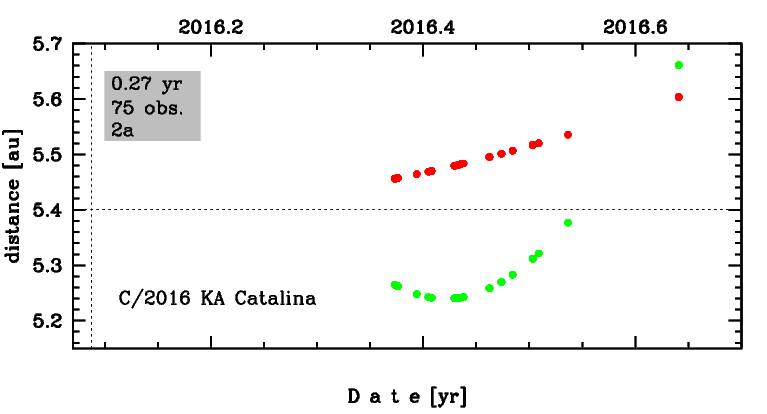C/2016 KA Catalina
more info
Comet C/2016 KA was discovered on 16 May 2016 with Catalina Sky Survey, that is about 3.5 months after its perihelion passage. This comet was observed about three months until 3 April 2017.
Comet had its closest approach to the Earth on 2 June 2016 (5.240 au), about 4 months after its perihelion passage and about 2 weeks after its discovery.
The preferred solution given here is based on data spanning over 0.88 yr in a range of heliocentric distances from 5.46 au to 6.24 au.
This comet suffers insignificant planetary perturbations during its passage through the planetary system; have orignal and future semimajor axes shorter than 5000 au.
Comet had its closest approach to the Earth on 2 June 2016 (5.240 au), about 4 months after its perihelion passage and about 2 weeks after its discovery.
The preferred solution given here is based on data spanning over 0.88 yr in a range of heliocentric distances from 5.46 au to 6.24 au.
This comet suffers insignificant planetary perturbations during its passage through the planetary system; have orignal and future semimajor axes shorter than 5000 au.
| solution description | ||
|---|---|---|
| number of observations | 75 | |
| data interval | 2016 05 16 – 2016 08 22 | |
| data type | observed only after perihelion (POST) | |
| data arc selection | entire data set (STD) | |
| range of heliocentric distances | 5.46 au – 5.56au | |
| detectability of NG effects in the comet's motion | NG effects not determinable | |
| type of model of motion | GR - gravitational orbit | |
| data weighting | NO | |
| number of residuals | 144 | |
| RMS [arcseconds] | 0.47 | |
| orbit quality class | 2a | |
| orbital elements (heliocentric ecliptic J2000) | ||
|---|---|---|
| Epoch | 2016 02 22 | |
| perihelion date | 2016 02 01.44018097 | ± 0.03769277 |
| perihelion distance [au] | 5.40087184 | ± 0.00008770 |
| eccentricity | 0.99929533 | ± 0.00016494 |
| argument of perihelion [°] | 63.110963 | ± 0.004463 |
| ascending node [°] | 317.560667 | ± 0.000944 |
| inclination [°] | 104.629923 | ± 0.00011 |
| reciprocal semi-major axis [10-6 au-1] | 130.47 | ± 30.54 |
